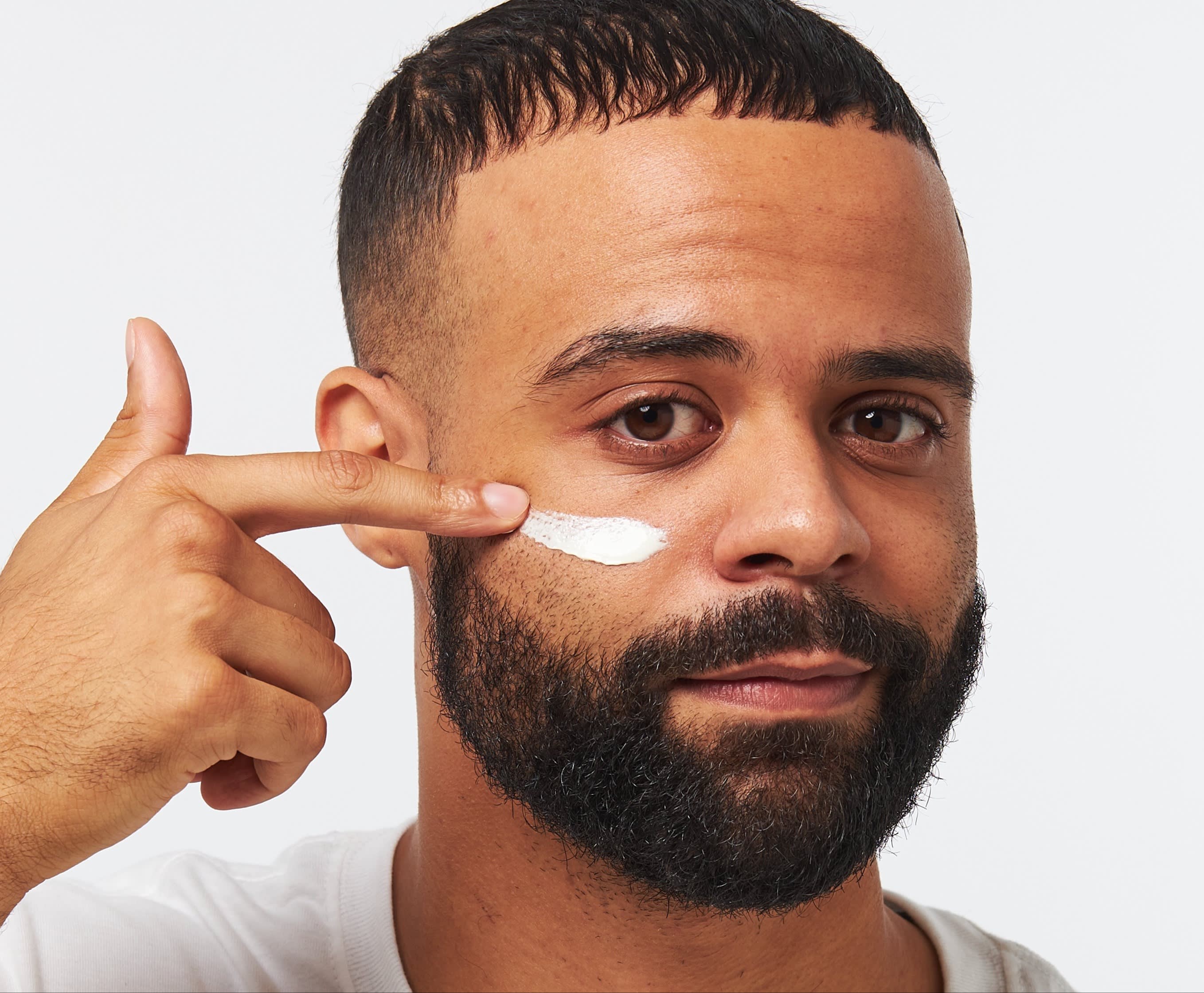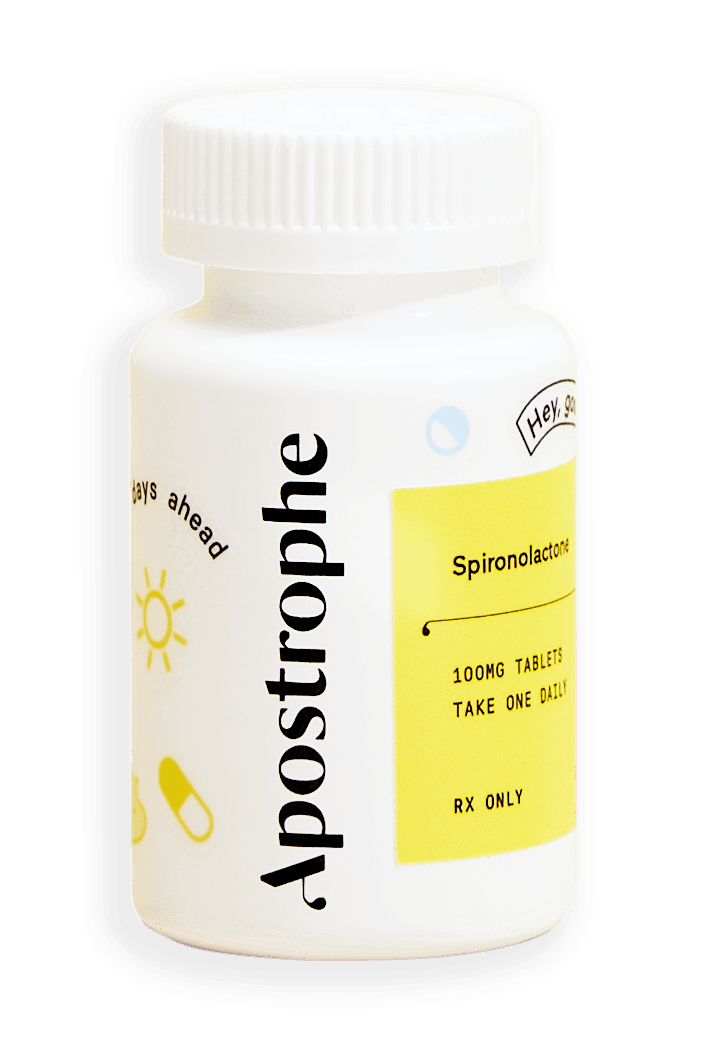General
Pomade Acne: Causes, Symptoms, and Treatment


SHARE
General
Pomade Acne: Causes, Symptoms, and Treatment
Medically reviewed by Katelyn Hagerty FNP
Written by Apostrophe Team
Last updated 11/1/2024
The right pomade can make styling your hair easy.
Unfortunately, it may also clog the pores on your hairline and forehead, potentially contributing to breakouts of whiteheads, blackheads, and other types of acne.
Pomade acne can be a serious annoyance, especially when it causes you to develop severe or persistent breakouts.
However, like other forms of acne, it’s almost always treatable. Below, we’ve explained how and why pomade acne develops, as well as the symptoms you may notice if you’re prone to pomade acne breakouts.
Finally, we’ve discussed what you can do to treat acne that’s caused by pomade, wax, and other styling products and enjoy clear skin throughout the year.
What Causes Pomade Acne?
Whiteheads, blackheads, and other types of acne usually form when your hair follicles, or pores, become clogged with a mix of sebum and dead skin cells.
Sebum is an oily substance that’s secreted by your sebaceous glands -- small glands located in your skin.
It plays a key role in protecting and maintaining your skin by sealing in moisture and creating a protective barrier against germs, fungi, and other pathogens.
Although some amount of sebum is vital for healthy skin, when your sebaceous glands secrete too much sebum, your skin can become wet and oily.
As excess sebum collects on the surface layer of your skin, it can make its way into your pores and contribute to blockages.
Dead skin cells are created as a byproduct of epidermal turnover, a process by which your skin repairs, renews, and maintains itself.
Epidermal turnover starts in the stem cells located deep inside your skin. These cells generate “daughter cells” that gradually move upwards towards the surface layer, replacing your old skin cells in the process.
On average, it takes 40 to 56 days for your epidermis -- the thin, outermost layer of your skin -- to turn itself over. As this occurs, the leftover skin cells form into a layer of dead, cornified cells called the stratum corneum, which is eventually shed into the environment.
When excess sebum and dead skin cells build up on the surface of your skin, they can mix with each other and form plugs inside your pores, resulting in acne.
Acne varies in severity. Mild forms of acne, such as comedones, form when your pores become clogged with sebum and dead skin cells.
More severe forms of acne, such as inflammatory acne, nodular acne, and cystic acne, develop when bacteria multiply inside the pores, causing inflammation and discomfort.
So, how does pomade fit into this process? Although pomade doesn’t have any impact on your skin’s production of sebum or new cells, many pomades are made with oils and waxes that can build up on your skin and, just like sebum, mix with dead skin cells to clog your pores.
Common oils and waxes used to produce pomade include petroleum, lanolin, beeswax, coconut oil, and castor oil.
Symptoms of Pomade Acne
The most common symptom of pomade acne is, well, acne. You may notice that you get more acne breakouts after you start styling your hair with pomade, wax, or other hair styling products that can clog your pores.
Notable symptoms of pomade acne include:
Acne on your hairline and forehead. Most acne caused by hair styling products forms on your forehead and near your hairline. You may notice that most of your acne appears in areas where your pomade is concentrated, such as around your temples.
Acne on your scalp. Pomade and other hair styling products may also cause acne that affects your scalp.
Persistent acne that doesn’t improve. If pomade is causing your acne, you may notice that your acne never seems to go away. As one set of acne lesions clears, another might develop in its place.
If you notice these symptoms, it’s best to take action as early as you can. Acting quickly helps to get rid of breakouts and prevent more acne from developing before your acne breakouts have a chance to become more severe.
Types of Acne
Although lots of people use the word “acne” to refer to any type of acne lesion, the reality is that acne can vary hugely in severity, from mild, non-inflammatory acne to infected and painful forms of acne that can be challenging to treat.
If you’re prone to pomade acne breakouts, you may develop the following forms of acne on your forehead and hairline:
Comedonal acne. Comedones are mild acne lesions that can develop when your pores become clogged with oil and skin cells. Whiteheads and blackheads (also referred to as closed and open comedones) are common types of comedonal acne.
Inflammatory acne. This type of acne is inflamed, swollen, and tender, usually because of inflammation caused by bacterial infection. Papules and pustules (pus-filled pimples) are common types of inflammatory acne.
Nodular and cystic acne. Nodules are large inflammatory acne lesions that look similar to bumps under your skin. Cystic acne is a severe form of inflamed acne that may cause significant discomfort and leave behind permanent acne scarring.
Can Other Hair Products Cause Acne?
Yes. Although hairline and forehead acne is commonly associated with pomade, other hair care and styling products may also clog your pores and contribute to acne breakouts.
Other hair care products that may cause to contribute to acne include:
Shampoos
Conditioners
Clays and waxes
Hairsprays
Styling gels
It’s also possible for products that you apply to your face to cause acne. Skin creams, lotions, and even shaving products such as shaving cream and aftershave can all include ingredients that clog pores or cause skin irritation.
How to Treat Pomade Acne
Like other forms of acne, pomade acne is treatable. You can treat this form of acne by making changes to your hair care habits, adding some simple skincare products to your skincare routine, or for more severe breakouts, by using acne medication.
Lifestyle Changes & Hair Care Habits
If you only have mild pomade acne, you may be able to get rid of it by making a few changes to your hair styling habits.
Try the following techniques to prevent your hair products from affecting your skin and causing acne breakouts:
Be careful when applying pomade. When you apply pomade to your hair, try to limit the amount that you use near your hairline. Try to apply pomade to the middle and tips of your hair, rather than the roots, as this may prevent it from touching your skin.
Use a water-based pomade. This type of pomade contains water rather than the oils used in other hair care products. Not only is it less likely to clog pores -- it’s also much easier to rinse out of your hair at the end of the day.
Stop using pomade. Another option is to simply stop using pomade. Try styling your hair with a non-comedogenic gel or other product, or simply take a break from styling products while your acne clears.
Check your other skin and hair products. Make sure to double-check any other skin and hair care products for oils, waxes, and other ingredients that could clog your pores and cause acne breakouts.
Wash your hair often. Make sure to wash your pomade out of your hair at the end of the day. Use a good quality, non-comedogenic shampoo and make sure that your hair doesn’t feel oily before you go to bed.
Shower after you work out. When you work out, sweat from your scalp can cause the oils in pomades, waxes, and other hair styling products to drip down onto your forehead and contribute to acne breakouts. Try to shower as soon as you’re done working out. This not only washes away pomade -- it’s also a great way to clean away the bacteria that can cause infected and inflamed acne to develop.
Clean any items that touch your scalp. Oils from pomade, wax, and other hair styling products can easily soak into pillowcases, sheets, hats, and other items that come into direct contact with your hair and scalp. Make sure to wash these items regularly to prevent oils and other residues from building up, as these substances can potentially make their way onto your skin and cause acne breakouts.
Avoid popping hairline and forehead pimples. If you notice a pimple on your hairline, don’t pop it by yourself. As tempting as it might feel, popping pimples increases your risk of dealing with infections, pain, and acne scars.
Over-the-Counter Skin Care Products
If your pomade acne doesn’t improve after making changes to your hair care routine, you might want to consider using an over-the-counter acne treatment.
One of the best ways to treat acne is by using a facial cleanser. To get rid of breakouts and stop them from coming back, look for an over-the-counter cleanser that contains one of the following ingredients:
Salicylic acid. A beta-hydroxy acid (BHA), salicylic acid reduces swelling and promotes the shedding of old, dead skin cells. You can find salicylic acid in many acne cleansers, as well as topical creams, masks, and other products.
Benzoyl peroxide. Benzoyl peroxide works by stopping acne-causing bacteria, such as Propionibacterium acnes (P. acnes) from growing on your skin. It’s a good ingredient to look for if you get inflamed, infected acne on your forehead and around your hairline.
Prescription Acne Medication
If you have forehead or hairline acne that’s severe or persistent, over-the-counter products may not quite cut it as treatments. In this case, it’s usually best to use prescription medication to get your breakouts under control and keep your skin clear in the future.
Common prescription medications for acne include:
Tretinoin. A popular topical retinoid, tretinoin works by peeling away dead skin cells and unclogging your pores. It’s used to treat acne, but also has anti-aging effects that make it a great all-around skin care medication.
Clindamycin. A topical antibiotic, clindamycin stops acne-causing bacteria from growing on your skin. Your healthcare provider may suggest using clindamycin if you have acne that’s inflamed due to bacteria such as P. acnes.
For more severe acne, your healthcare provider may prescribe oral acne medications, such as antibiotics or isotretinoin.
These are highly effective at treating acne, but can cause side effects that you should be aware of before use.
Our guide to prescription acne medication goes into further detail about how these medications work, their effects, side effects, and more.
Treating Pomade Acne
Pomade, wax, clay, and other hair products are great for styling your hair. However, because of their oil content, they have the potential to clog your pores and cause acne breakouts that affect your scalp, hairline, and forehead.
To get rid of pomade acne, try switching to a non-comedogenic, water-based pomade, or cutting pomade and other oil-based products out from your hair styling routine for a while.
If you have persistent acne, proven skin care products such as our Tretinoin are ideal for getting your breakouts under control and enjoying clear, acne-free skin.
11 Sources
Hoover, E., Aslam, S. & Krishnamurthy, K. (2020, October 26). Physiology, Sebaceous Glands. StatPearls. Retrieved from https://www.ncbi.nlm.nih.gov/books/NBK499819/
Koster, M.I. (2009, July). Making an epidermis. Annals of the New York Academy of Sciences. 1170, 7–10. Retrieved from https://www.ncbi.nlm.nih.gov/pmc/articles/PMC2861991/
Acne. (n.d.). Retrieved from https://www.americanskin.org/resource/acne.php
Are Your Hair Care Products Causing Breakouts? (n.d.). Retrieved from https://www.aad.org/public/diseases/acne/causes/hair-products
Is Your Workout Causing Your Acne? (n.d.). Retrieved from https://www.aad.org/public/diseases/acne/causes/workouts
Pimple Popping: Why Only a Dermatologist Should Do It. (n.d.). Retrieved from https://www.aad.org/public/diseases/acne/skin-care/popping
Salicylic Acid Topical. (2016, September 15). Retrieved from https://medlineplus.gov/druginfo/meds/a607072.html
Matin, T. & Goodman, M.B. (2020, November 24). Benzoyl Peroxide. StatPearls. Retrieved from https://www.ncbi.nlm.nih.gov/books/NBK537220/
Tretinoin Topical. (2019, March 15). Retrieved from https://medlineplus.gov/druginfo/meds/a682437.html
Clindamycin Topical. (2016, October 15). Retrieved from https://medlineplus.gov/druginfo/meds/a609005.html
American Academy of Dermatology Association. (n.d.). 10 TIPS FOR CLEARING ACNE IN SKIN OF COLOR. https://www.aad.org/public/diseases/acne/diy/skin-color
Shop this post

Safety Information About Isotretinoin

Tretinoin

Clindamycin
Like what you just read? Sign up for our email list to get the scoop on skincare science delivered straight to your inbox.

Deep Dives
A dermatologist shares his thoughts on the recent studies about benzoyl peroxide and benzene.
Read More
Education
What is milia?
What is milia? Today, we’re jumping into one type of bump that you may have heard about most commonly in infants — milia.
Read More
Education
Best moisturizer for acne-prone skin
If you have combination acne-prone skin, figuring out which moisturizer is best for your skin might be tough. In this guide, we break down the best moisturizer for combination, acne-prone skin.
Read More
